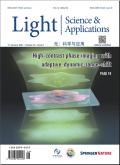Scaling up for end-to-end on-chip photonic neural network inference.
IF 23.4
Q1 OPTICS
引用次数: 0
Abstract
Optical neural networks are emerging as a competitive alternative to their electronic counterparts, offering distinct advantages in bandwidth and energy efficiency. Despite these benefits, scaling up on-chip optical neural networks for end-to-end inference is facing significant challenges. First, network depth is constrained by the weak cascadability of optical nonlinear activation functions. Second, the input size is constrained by the scale of the optical matrix. Herein, we propose a scaling up strategy called partially coherent deep optical neural networks (PDONNs). By leveraging an on-chip nonlinear activation function based on opto-electro-opto conversion, PDONN enables network depth expansion with positive net gain. Additionally, convolutional layers achieve rapid dimensionality reduction, thereby allowing for an increase in the accommodated input size. The use of a partially coherent optical source significantly reduces reliance on narrow-linewidth laser diodes and coherent detection. Owing to their broader spectral characteristics and simpler implementation, such sources are more accessible and compatible with scalable integration. Benefiting from these innovations, we designed and fabricated a monolithically integrated optical neural network with the largest input size and the deepest network depth, comprising an input layer with a size of 64, two convolutional layers, and two fully connected layers. We successfully demonstrate end-to-end two-class classification of fashion images and four-class classification of handwritten digits with accuracies of 96% and 94%, respectively, using an in-situ training method. Notably, performance is well maintained with partially coherent illumination. This proposed architecture represents a critical step toward realizing energy-efficient, scalable, and widely accessible optical computing.扩展端到端片上光子神经网络推理。
光神经网络在带宽和能源效率方面具有明显的优势,正在成为电子网络的竞争替代品。尽管有这些好处,扩展端到端推理的片上光学神经网络仍面临着重大挑战。首先,网络深度受到光学非线性激活函数的弱级联性的限制。其次,输入尺寸受光学矩阵尺度的限制。在此,我们提出了一种称为部分相干深度光神经网络(PDONNs)的扩展策略。通过利用基于光电转换的片上非线性激活函数,PDONN使网络深度扩展具有正净增益。此外,卷积层实现了快速降维,从而允许增加可容纳的输入大小。部分相干光源的使用大大减少了对窄线宽激光二极管和相干检测的依赖。由于其更广泛的光谱特性和更简单的实现,这些源更容易获得,并且与可扩展集成兼容。得益于这些创新,我们设计并制造了一个具有最大输入尺寸和最深网络深度的单片集成光学神经网络,包括大小为64的输入层,两个卷积层和两个完全连接层。我们使用原位训练方法成功地演示了端到端时尚图像的两类分类和手写数字的四类分类,准确率分别为96%和94%。值得注意的是,在部分相干照明下,性能保持得很好。提出的体系结构是实现节能、可扩展和可广泛访问的光学计算的关键一步。
本文章由计算机程序翻译,如有差异,请以英文原文为准。
求助全文
约1分钟内获得全文
求助全文
来源期刊

Light-Science & Applications
数理科学, 物理学I, 光学, 凝聚态物性 II :电子结构、电学、磁学和光学性质, 无机非金属材料, 无机非金属类光电信息与功能材料, 工程与材料, 信息科学, 光学和光电子学, 光学和光电子材料, 非线性光学与量子光学
自引率
0.00%
发文量
803
审稿时长
2.1 months
 求助内容:
求助内容: 应助结果提醒方式:
应助结果提醒方式:


